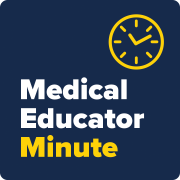Medical Educator Minute – Setting the (feedback) stage
Starting this week, we’re launching a new monthly feature in Academics This Week called “Medical Educator Minute”, which will feature quick tips for teaching, giving and receiving feedback, and improving the learning environment based on the literature and curated by Dr. Elizabeth Chawla and Dr. Sarah Thornton. Our first feature below focuses on the importance of ‘setting the stage’ for feedback.
Setting the (feedback) stage:
Feedback conversations can be challenging for both educators and learners: educators often don’t know what to say or where to start, may be concerned about how their feedback will be received, or feel their time with the learner was too limited to make a comprehensive assessment. Learners can be equally unsatisfied if they are not able to reflect on feedback given, find it unhelpful because feedback does not align with their learning goals, or fail to get any specific feedback. So how can we ensure any time with learners facilitates opportunities for feedback and professional development?
Any interaction with a learner, even if brief, can use the following framework:
- Set Expectations – it’s important for both the educator and the learner to understand what is required for the interaction or rotation. At the beginning of a week on service, the beginning of a surgical case or procedure, the start of an ER shift, or the start of a clinic session, the educator should clearly state expectations for the learner.
- Learner-Driven Goals – the learner should identify and communicate to the educator specific goals for the time they have with the educator, based on their personal professional growth, current level of performance or experience, and time available. e.g., “I really want to work on my procedural skills during this ER shift.” The educator may need to help ensure goals are feasible and practical to the clinical space and that the goals align with stated learner curriculum.
- Set a Time for Feedback – setting the expectation for a time and space for feedback at the beginning will help both the learner and educator feel prepared for the conversation, ensure it happens in a timely manner, and at a time when the learner is open to receiving the feedback. e.g., “at the end of the case, at the end of the shift, at the end of the month.” Remind the learner that self-reflection of performance and goals will be part of the feedback discussion.
Feedback conversations can be framed by recalling previously stated expectations and learner-stated goals set at the beginning of the interaction. Self-reflection is a critical part of receiving feedback. e.g., “What went well? What would you like to work on for next time?” Setting the stage can be very useful for ensuring feedback conversations are focused, timely, and productive, even during busy clinical loads.
To learn more, check out this article by Burgess et al about feedback in the clinical learning environment.
Elizabeth Chawla, MD, Sarah Thornton, MD




